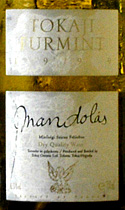|
Offbeat grapes and wine: Furmint
Let's wrap up the work week with a quick trip down another of wine's less-traveled byways: Furmint ("Foor-mint"), the white grape best-known as a major player in Hungary's great dessert wine Tokaji ("Toe-kay"), turns up occasionally as a dry white wine in Hungary and neighboring parts of Austria. Unlike its partner in the Tokaji blend, the thoroughly Hungarian Hárslevelü (which, as far as I know, is never produced as a single-varietal wine), Furmint traces its linguistic heritage not to Budapest but Rome: Early vine growers supposedly took its name from the Latin word "frumentum," meaning "wheat," because of the grape's golden-tan color. (While we're on the subject of Tokaji, by the way, let's take a moment to note that the Tocai Friulano of Northeastern Italy and the Tokay d'Alsace of France are unrelated to Tokaji except by name, a source of linguistic confusion that the European Union's regulators intend to clear up by banning the names of the sound-alike grapes.) Furmint is an obvious candidate for dessert wine because its thin skin makes it a receptive host for Botrytis cinerea, the beneficial mold called "noble rot" that randomly infests some late-harvested grapes, causing them to shrink and dry so the natural sugars become highly concentrated, producing intensely sweet wine. As a dry wine, Furmint is typically full-bodied and acidic (think of a Chardonnay with muscles), with bold flavors that the British wine journalist Jancis Robinson describes as "fiery." Robinson, who among other things is a leading wine-grape expert, also advises that Furmint be drunk up while it's young and fresh. But I recently ran across a dusty stash of bottles from the 1999 vintage in a local store - two or three years behind the current release - and to my pleased surprise found that it had gained real richness and complexity with a bit of age, despite presumably having been kept in less than pristine cellar conditions. This fairly widely distribruted version from Oremus, a leading Tokaji producer, is worth seeking out as a wine of very good value; and if you can't find an older vintage, there'd be no harm in putting a more recent bottle or two away to sleep for a while. (I had tasted the 1998 vintage of this wine in the autumn of 2000, just two years after the harvest, and it was pleasant but much more simple and one-dimensional. Age has served this one well.)
TALK ABOUT WINE ONLINE If you prefer to comment privately, feel free to send me E-mail at wine@wineloverspage.com. I'll respond personally to the extent that time and volume permit.
This clear, brass-color wine presents rich and complex aromas of white fruit and butter, with almonds and hazelnuts as subtle background notes. Medium-bodied, fresh and tart, it's more youthful on the palate than the nose: juicy tropical fruit balanced by mouth-watering acidity, with snappy lemons in a very long finish. U.S. importer: Europvin USA, Oakland, Calif. (June 9, 2004) FOOD MATCH: The wine's acidity and richness would make it a great match with pan-seared scallops, good with a broad range of seafood and fish; it worked nicely, too, with a vegetarian pasta dish, broccoli tossed over rigatoni with a Mornay-style sauce made with Swiss Gruyere Reserve. VALUE: Excellent value at this under-$10 price. WHEN TO DRINK: As noted, this wine is carrying two or three years of age very well indeed. Those still-subtle nutlike oxidative qualities suggest, though, that the 1999s should be drunk up soon, particularly if not carefully cellared.
WEB LINK: Oremus, a corporate sibling of the Spanish Vega Sicilia group, offers its Website in Spanish, Hungarian and English:
FIND THIS WINE ONLINE: Find vendors and check prices for Oremus Furmint on Wine-Searcher.com, Administrivia To subscribe or unsubscribe from The 30 Second Wine Advisor, change your E-mail address, or for any other administrative matters, please use the individualized hotlink found at the end of your E-mail edition. If this is not practical, contact me by E-mail at wine@wineloverspage.com, including the exact E-mail address that you used when you subscribed, so I can find your record. We do not use our E-mail list for any other purpose and will never give or sell your name or E-mail address to anyone. I welcome feedback, suggestions, and ideas for future columns. To contact me, please send E-mail to wine@wineloverspage.com All the wine-tasting reports posted here are consumer-oriented. In order to maintain objectivity and avoid conflicts of interest, I purchase all the wines I rate at my own expense in retail stores and accept no samples, gifts or other gratuities from the wine industry.
Friday, June 11, 2004 |

 Oremus 1999 "Mandolás" Tokaji Furmint Dry ($8.99)
Oremus 1999 "Mandolás" Tokaji Furmint Dry ($8.99)



